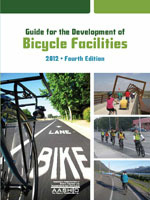Last week, AASHTO, the national association of state DOTs, published the first update to its bicycle facility design guide in 13 years (available online for $144). Since many transportation engineers take their cues from AASHTO, there was an urgent need to update the 1999 guide, which failed to include many effective design treatments and promoted some standards that actually made streets more dangerous. The new guide includes some significant steps forward, but it still lacks the bikeway designs widely recognized as the best practice for making cycling a mainstream mode of transport.
AASHTO is saying all the right things as it publicizes the update. "Transportation engineers know that the entire system works more efficiently when we build streets, bridges, and highways that can accommodate bicyclists and pedestrians in the safest way possible," AASHTO Director John Horsley said in a statement.
And the guide has ballooned from 70 to 200 pages, adding much more detailed information about buffered bike lanes, bike parking, bike boulevards, and travel lane narrowing. Still, it leaves out protected bike lanes, also known as cycle tracks, which the world's best bicycling cities -- and America's most bike-friendly transportation departments -- have employed to make biking safer and broadly accessible.
AASHTO says it has incorporated the strategy, popularized by the Portland Bureau of Transportation, to design streets for the 60 percent of people who are interested in biking but concerned about safety. "It's sanctioned there as methodology," said Bill Schultheiss of Toole Design Group, which took the lead on writing the new guide. "It's a big deal."
Schultheiss says that a cycle track is nothing but a bicycle-only trail, and bicycle-only trails are in there. But unlike cycle tracks, bike trails are not designed to run on streets that also include motor vehicle traffic. Advocates say there's a big difference -- a difference that matters to the "interested but concerned" population. Darren Flusche of the League of American Bicyclists says cities that have made cycling a priority will still go beyond the AASHTO guide and use the bikeway design guide developed by the National Association of City Transportation Officials, which includes on-street, protected bike lanes and other innovative designs. "NACTO has left AASHTO behind."
NACTO itself identified the lack of protected bikeway designs as a critical oversight in the AASHTO guide. "NACTO’s Urban Bikeway Design Guide has been leading the way for cities to build streets that are safe for kids, adults, and older people alike who want to bicycle," said NACTO Executive Director Ron Thaniel in an email. "In contrast, AASHTO’s latest edition of its bicycle design guide has virtually no guidance for on-street protected bicycle paths, despite the fact that they are a growing standard around the country."
The Bikes Belong coalition and NACTO are helping several cities adopt designs that AASHTO has yet to include. While these bikeway designs have proven safety records in major cities and the NACTO guide has the endorsement of Transportation Secretary Ray LaHood, places with more timid transportation engineers will probably still look to AASHTO. "The AASHTO guide sets the standard," Flusche said, "and so it's important that it be comprehensive in the tools it allows planners and engineers to use, because many agencies won’t go beyond it. There's a strong sense that if you follow the AASHTO guidelines, you're protected from liability."
On the plus side, the new AASHTO guide includes several improvements over the previous one. It recognizes different types of bikes and attachments like trailers, and acknowledges that some of these require wider and buffered bikeways. Incorporating bike lanes with angled car parking used to be unheard of -- now it's in the manual.
And it's more explicit about the fact that widening the travel lane to 13 or 14 feet isn't the best way to accommodate bikes. "This guide now says, 'A wide outside lane is okay but in the scheme of things, it's not preferred,'" said Schultheiss. "Bike lanes would be better. That's important because the last round of guidance resulted in state DOTs saying, 'Well now we're going to do wide outside lanes to accommodate cycling,' so now there's hundreds if not thousands of miles of roads built like that -- which frankly would have been better if they were built with bike lanes to start with."
Schultheiss also said AASHTO is hoping to move toward five-year updates. Thirteen years would be a long time to wait for state DOTs to finally sanction protected bike lanes.






